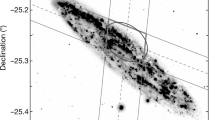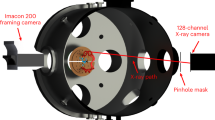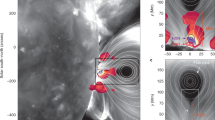Abstract
SOLAR flares are thought to be the result of magnetic reconnection — the merging of antiparallel magnetic fields and the consequent release of magnetic energy. Flares are classified into two types1: compact and two-ribbon. The two-ribbon flares, which appear as slowly-developing, long-lived large loops, are understood theoretically2–6 as arising from an eruption of a solar prominence that pulls magnetic field lines upward into the corona. As the field lines form an inverted Y-shaped structure and relax, the reconnection of the field lines takes place. This view has been supported by recent observations7–10. A different mechanism seemed to be required, however, to produce the short-lived, impulsive compact flares. Here we report observations made with the Yohkoh11 Hard X-ray Telescope12 and Soft X-ray Telescope13, which show a compact flare with a geometry similar to that of a two-ribbon flare. We identify the reconnection region as the site of particle acceleration, suggesting that the basic physics of the reconnection process (which remains uncertain) may be common to both types of flare.
This is a preview of subscription content, access via your institution
Access options
Subscribe to this journal
Receive 51 print issues and online access
$199.00 per year
only $3.90 per issue
Buy this article
- Purchase on Springer Link
- Instant access to full article PDF
Prices may be subject to local taxes which are calculated during checkout
Similar content being viewed by others
References
Pallavicini, R. Phil. Trans. R. Soc. A336, 389–400 (1991).
Carmichael, H. in AAS-NASA Symp. on the Physics of Solar Flares, NASA-SP 5O (ed. Hess, W. N.) 451–456 (NASA, Washington DC, 1964).
Sturrock, P. A. Nature 211, 695–697 (1966).
Hirayama, T. Sol. Phys. 34, 323–338 (1974).
Kopp, R. A. & Pneuman, G. W. Sol. Phys. 50, 85–98 (1976).
Hayvaerts, J., Priest, E. R. & Rust, D. M. Astrophys. J. 216, 123–137 (1977).
Tsuneta, S. et al. Publs astr. Soc. Japan 44, L63–L69 (1992).
Tsuneta, S. in The Magnetic and Velocity Fields of Solar Active Regions, IAU Colloq. 141 (eds Zirin, H., Ai, G. & Wang, H.) 239–248 (Astr. Soc. Pacific, San Francisco, 1993).
Tsuneta, S. in X-Ray Solar Physics from Yohkoh (eds Uchica, Y., Watanabe, T., Shibata, K. & Hudson, H. S.) 115–119 (Universal Academy Press, Tokyo, 1994).
Tsuneta, S. et al. Publs astr. Soc. Japan 44, L211–L214 (1992).
Ogawara, Y. et al. Sol. Phys. 136, 1–16 (1991).
Kosugi, T. et al. Sol. Phys. 136, 17–36 (1991).
Tsuneta, S. et al. Sol. Phys. 136, 37–67 (1991).
Hoyng, P. et al. Astrophys. J. 244, L153–L156 (1981).
Duijveman, A., Hoyng, P. & Machado, M. E. Sol. Phys. 81, 137–157 (1982).
Sakao, T. thesis, Univ. Tokyo (1994).
Hudson, H. S. et al. Astrophys. J. 422, L25–L27 (1994).
Hudson, H. S. in High-Energy Solar Phenomena—A New Era of Spacecraft Measurements AIP Conf. Proc. 294 (eds Ryan, J. M. & Vestrand, W. T.) 151–161 (AIP, New York, 1994).
Haisch, B., Strong, K. T. & Rodono, M. A. Rev. Astr. Astrophys. 29, 275–324 (1991).
Brown, J. C. Sol. Phys. 18, 489–502 (1971).
Hudson, H. S., Canfield, R. C. & Kane, S. R. Sol. Phys. 60, 137–142 (1978).
Masuda, S. thesis, Univ. Tokyo (1994).
Author information
Authors and Affiliations
Rights and permissions
About this article
Cite this article
Masuda, S., Kosugi, T., Hara, H. et al. A loop-top hard X-ray source in a compact solar flare as evidence for magnetic reconnection. Nature 371, 495–497 (1994). https://doi.org/10.1038/371495a0
Received:
Accepted:
Issue Date:
DOI: https://doi.org/10.1038/371495a0
This article is cited by
-
Energy Definition and Minimization in Avalanche Models for Solar Flares
Solar Physics (2024)
-
Circular-ribbon flares and the related activities
Reviews of Modern Plasma Physics (2024)
-
Ion and electron acoustic bursts during anti-parallel magnetic reconnection driven by lasers
Nature Physics (2023)
-
Generation of intense magnetic wakes by relativistic laser pulses in plasma
Scientific Reports (2023)
-
Chromospheric Evaporation by Particle Beams in Multi-Dimensional Flare Models
Solar Physics (2023)
Comments
By submitting a comment you agree to abide by our Terms and Community Guidelines. If you find something abusive or that does not comply with our terms or guidelines please flag it as inappropriate.



